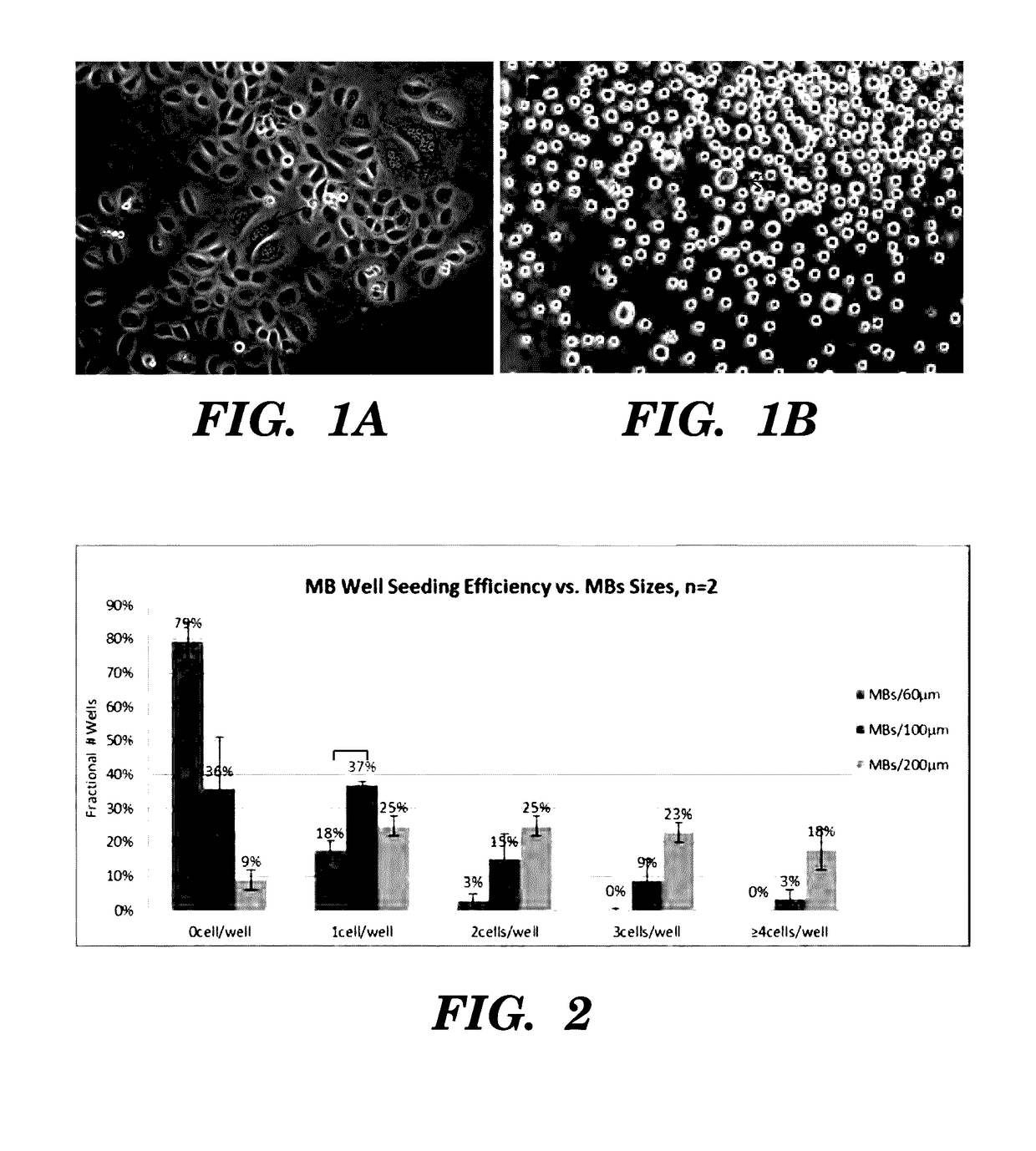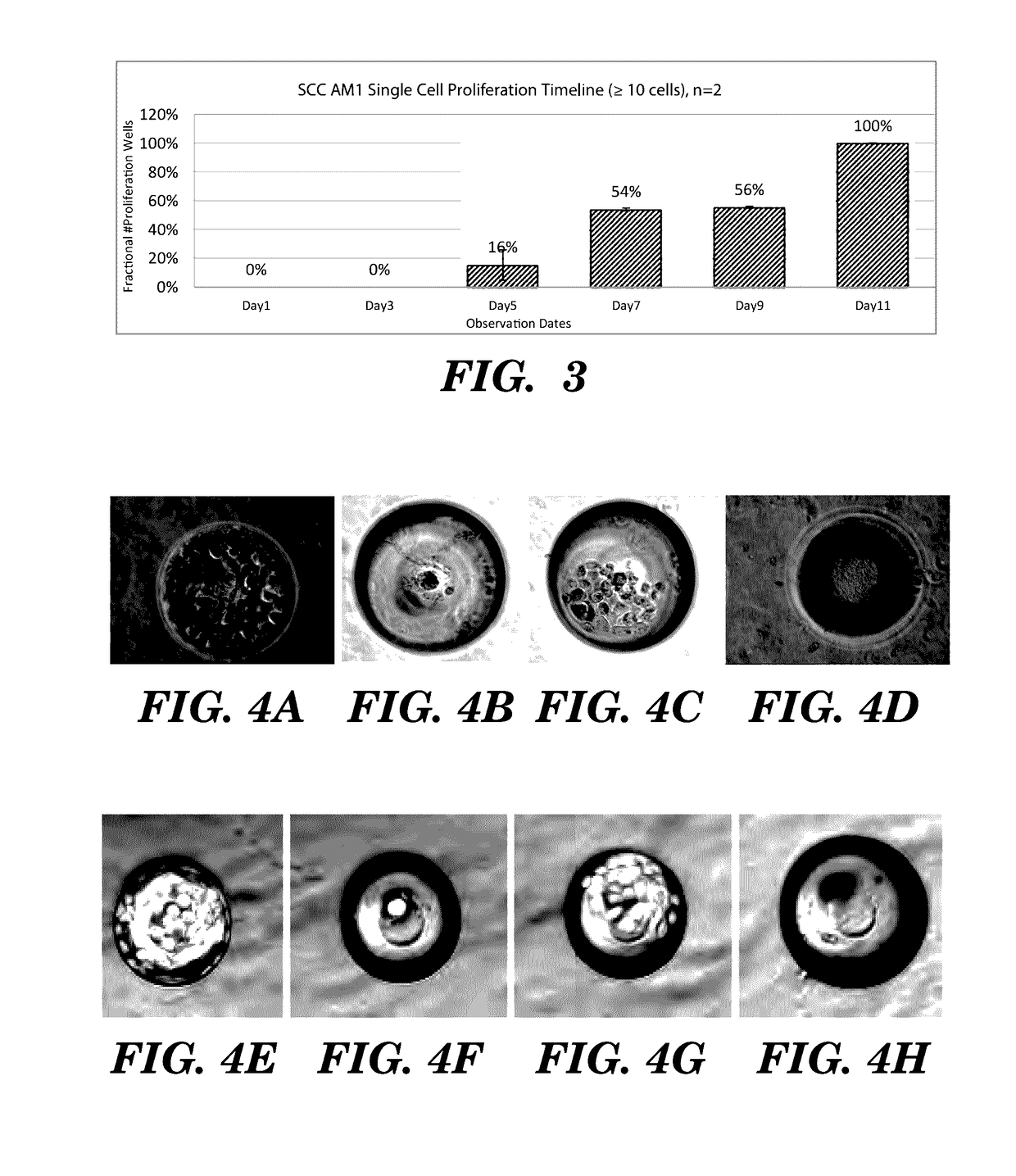High-throughput cellular analysis using microbubble arrays
- Summary
- Abstract
- Description
- Claims
- Application Information
AI Technical Summary
Benefits of technology
Problems solved by technology
Method used
Image
Examples
example 1
Sorting Tumor Initiating Cells by Clonal Proliferation and Morphology
[0085]Skin cancers comprise a large public health concern and an increasing burden on the health care system. Among 2 million diagnosed skin cancers annually in the U.S., ˜ 35% are squamous cell carcinomas (SCCs). SCC metastases account for the majority of non-melanoma skin cancer deaths. Tumor size and morphology are considered to be prognostic factors for recurrence, but there are no genetic mutations or predictive biomarkers that can be reliably use to identify tumor aggressiveness at an early stage. The characterization and quantification of cells with tumor initiating capability is essential for developing prognostic biomarkers and for advancing the basic understanding of metastases. Current methods of identifying tumor-initiating cells (TICs) are using flow cytometry and serial in vivo xenotransplantation models. However, the cell surface markers derived from these methods failed to identify consistent expres...
example 2
SCC Cytokeratin Gene Expression
[0096]Stem cells are immature cells and have the ability to develop into different cell types. To test whether SCC cells cultured in MBs express cytokeratin 5, validating a basal proliferative SCC phenotype, the expression of cytokeratin 5 and 10 was investigated. Briefly, a MB chip array was placed in 24-well TCP and then transferred into wells containing 1× PBS. It was then transferred into wells containing 10% formalin fixative with 0.1% Triton for 20 min at room temperature. The chip was rinsed twice with 1× PBS, and blocked with 2% BSA for 30 min to prevent any non-specific adsorption of antibodies. A mixture of primary keratin 5 and keratin 10 antibodies (500 μl of 1:500 dilution) in 2% BSA was pipetted onto the top of the chip. The TCP was placed in 4° C. fridge overnight in the dark. Then, the excess antibody solution was removed the next day and the chip was rinsed twice with 1× PBS. The TCP was placed on a shaker for 5 min. A mixture of secon...
example 3
Identification of Tumor Initiating Cells by Drug Resistance
[0098]According to an embodiment is a single-cell screening method using microbubble well arrays where morphologically distinct clone can be sorted by drug resistance. Genetic mutations in cancer cells give rise to their aggressive phenotype and their ability to proliferate in a nonadherent fashion with reduced drug sensitivity, which are hallmarks cancer stem cells. Seeding and establishing clonally pure cancer cell colonies in microbubble well arrays is a means to screen for drug resistance as shown in FIGS. 13A-C, 14A-B, and 15. It is shown that the spheroid cell populations are drug resistant and may be representative of tumor initiating cells or cancer stem cells. To enrich for the sphere cells, established colonies were cultured in the presence of a chemotherapeutic agent (e.g. Cisplatin). Traditional chemotherapeutic agents work by killing rapidly dividing cells, one of the main properties of most cancer cells. This m...
PUM
 Login to View More
Login to View More Abstract
Description
Claims
Application Information
 Login to View More
Login to View More - R&D
- Intellectual Property
- Life Sciences
- Materials
- Tech Scout
- Unparalleled Data Quality
- Higher Quality Content
- 60% Fewer Hallucinations
Browse by: Latest US Patents, China's latest patents, Technical Efficacy Thesaurus, Application Domain, Technology Topic, Popular Technical Reports.
© 2025 PatSnap. All rights reserved.Legal|Privacy policy|Modern Slavery Act Transparency Statement|Sitemap|About US| Contact US: help@patsnap.com



